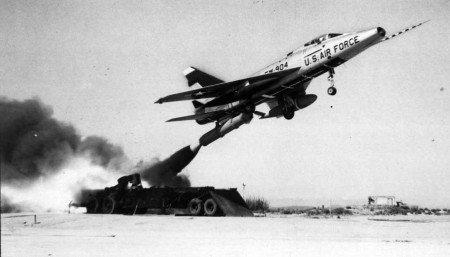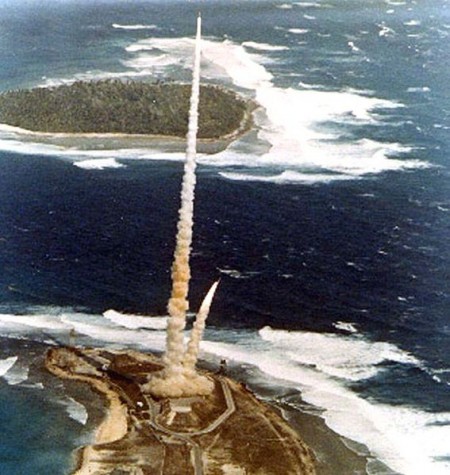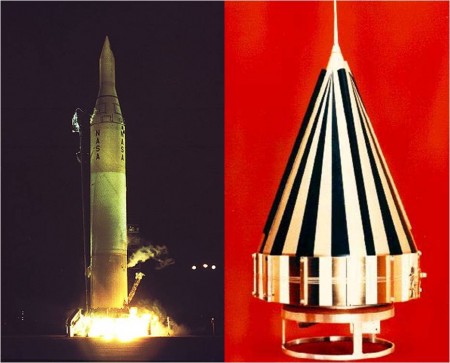
Fifty-one years ago this month, a USAF/Convair B-58A Hustler from the 43rd Bomb Wing at Carswell AFB, Texas set a trio of transcontinental speed records in a round trip from Los Angeles to New York and back. This historic feat was accomplished as part of Operation Heat Rise.
The USAF/Convair B-58A Hustler holds the distinction of being the world’s first supersonic bomber. A product of the 1950’s, the delta-winged aircraft measured 96.8 feet in length and had a wing span of 56.8 feet. GTOW stood around 163,000 lbs. Power was provided by a quartet of General Electric 79 turbojets which produced 62,000 lbs of sea level thrust in afterburner.
The Hustler’s performance was impressive then and now. With a maximum speed of 1,325 mph, the aircraft had a service ceiling of 64,800 feet and a combat radius of 1,520 nm. The Hustler’s mission range could be markedly increased via aerial refueling.
The B-58’s three man air crew sat in tandem in the order of pilot, navigator and Defensive Systems Officer (DSO). Each man occupied a separate flight station which was equipped with an ejection pod for protection during high speed egress.
The Hustler was part of Strategic Air Command. It’s primary mission was delivery of nuclear weapons. The aircraft served in the air force’s operational inventory for a period of just 10 years years (1960 to 1970). A total of 116 airframes were produced and none were used in anger.
The Hustler’s high speed capability led to the type being used to establish numerous speed records during its operational life. Operation Heat Rise was one such effort. The goal of this project was to establish segmental and overall speed records for a round trip flight between the west and east coasts of the United States.
On Monday , 05 March 1962, the crew of Major Robert G. Sowers (pilot), Captain Robert MacDonald (navigator) and Captain John T. Walton (DSO) departed Carswell AFB, Texas in B-58A S/N 59-2458. Other than a new wax job, the aircraft was no different than the other Hustler airframes in the inventory.
After refueling out over the Pacific Ocean, the aircraft started its coast-to-coast speed run at Mach 2 over Los Angeles, California. Incredibly, the critical ground station monitoring the start time did not record passage of the aircraft overhead. Thus, airplane and crew were called back for a restart! This meant another trip to the tanker out over the Pacific to top off the Hustler’s fuel tanks prior to the second try.
Once officially underway, the trip from overhead Los Angeles to overhead New York took 2 hours and 58.71 seconds for an average speed of 1,214.65 mph. The aircraft was refueled over Kansas on its way east. Once out over the Atlantic Ocean, the Hustler reversed course and hit the tanker again.
The return trip from overhead New York to overhead Los Angeles was flown in 2 hours, 15 minutes and 50.08 seconds. As on the eastbound leg, the Hustler took on a load of gas over Kansas. The entire round trip required 4 hours, 41 minutes and 14.98 seconds inclusive of refueling. Each of the aforementioned trip times established new performance records.
An interesting aspect of the return leg to Los Angeles was that the Hustler flew faster than the rotational movement of the earth. Thus, the aircraft and its crew arrived in California roughly 41 minutes earlier than the sun!
After landing in Los Angeles, the crew was enthusiastically greeted by members of the air force, the aerospace industry and the media. In recognition of their accomplishments, each man received the USAF Distinguished Flying Cross at the hand of USAF General Thomas S. Power, Chief of Staff.
Finally, for their impressive performance during Operation Heat Rise, crew and aircraft were the recipients of both the 1962 MacKay and Bendix Trophies. This marked the last time that the latter was ever awarded.

Fifty-five years ago this month, the first zero-length launch of an USAF/North American F-100D Super Sabre took place at Edwards Air Force Base, California. North American Test Pilot Albert R. Blackburn was at the controls of the experimental rocket-propelled test aircraft.
Zero-Length Launch (ZLL) was a concept pioneered by the United States Air Force for quickly getting aircraft into the air without the need for a conventional runway take-off. The idea was to launch the aircraft via rocket power from a standing start. Shortly after launch, the aircraft was at flight speed and the dead rocket booster was jettisoned.
The ZLL concept was typical of attempts by USAF to gain tactical advantage over the Soviet Union in any way possible during the Cold War era. ZLL held the promise of getting nuclear-armed combat aircraft airborne in the event that airfield runways were rendered useless due to enemy attack.
The ZLL mission was envisioned as one-way trip. Once airborne, a pilot was expected to fly to the target, deliver his nuclear weapon and then fend for himself. Survival options included finding a friendly field to land at or eject over non-hostile territory. Either way, the pilot’s chances of things working out well were not good.
The first attempt to test the ZLL concept dates back to 1953 when USAF employed the straight-wing USAF/Republic F-84G Thunderjet in the ZELMAL Program. ZELMAL stood for Zero Length Launch/ Mat Landing. This last part involved the aircraft making a wheels-up landing on an inflatable rubber mat that measured 800 ft x 80 ft x 3 ft.
Piloted ZELMEL flight tests were conducted at Edwards Air Force Base in 1954. The results were not particularly encouraging. Understandably, the mat landing was a rough go. The landing mat was heavily damaged on the first test and the pilot sustained back injuries that required months of recovery time. Subsequent flight tests showed ZELMAL to be essentially unworkable as then conceived.
USAF reprised the ZLL concept in 1958 with the F-100D Super Sabre. Gone was the mat landing part of the operation. The aircraft would make a normal wheels down landing if it got airborne successfully. Launch motive power was provided by a single Rocketdyne XM-34 solid rocket booster that generated 132,000 lbs of thrust for 4 seconds. At burnout of the boost motor, the F-100D was 400 feet above ground level and traveling at 275 mph. The booster was then jettisoned and the aircraft continued to accelerate under turbojet power.
The first flight test of the F-100 ZLL aircraft (S/N 56-2904) took place on Wednesday, 26 March 1958. The aircraft was launched from the south end of Rogers Dry Lake at Edwards Air Force Base, California. The test aircraft carried a pylon-mounted 275-gallon fuel tank on the right wing and a simulated nuclear store on a pylon under the left wing. North American’s Albert “Al” R. Blackburn served as the test pilot.
The first F-100 ZLL flight was entirely successful. Blackburn reported an exceptionally smooth ride on the rocket and an uneventful transition to turbojet-powered flight. While the boost motor struck the belly of the aircraft during departure and caused some superficial damage, the separation was otherwise successful. After a brief flight, Blackburn safely landed his steed on the concrete.
The first flight success of the ZLL Super Sabre was followed several weeks later by loss of aircraft 56-2904. Although the launch phase was proper, the boost motor hung-up on its support bolts and could not be jettisoned following burnout. Blackburn’s attempts to shake the dead motor free from the aircraft proved futile. Since a successful landing was not possible, he had to eject.
A total of fourteen (14) more F-100D ZLL flights took place at Edwards through October of 1958. Although these flights proved ZLL to be a viable means for getting a combat aircraft airborne without the use of a conventional runway take-off, USAF ultimately judged the concept to be too impractical and logistically burdensome to field. This in spite of the fact that a total of 148 F-100D Super Sabre aircraft were eventually modified for the ZLL mission.

Forty-two years ago this month, a pair of SPRINT ABM interceptors fired from the Kwajalein Missile Range intercepted a reentry vehicle launched from Vandenberg Air Force Base, California. It was the first salvo launch of the legendary hypersonic interceptor.
The Safeguard Anti-Ballistic Missile (ABM) System was developed between the mid-960’s and mid-1970’s to protect United States ICBM sites. Safeguard consisted of an exoatmospheric missile (Spartan) and an endoatmospheric interceptor (SPRINT). In today’s missile defense parlance, we would refer to these vehicles as mid-course and terminal phase interceptors, respectively.
The 3-stage Spartan measured 55 feet in length, weighed 28,700 pounds at launch and had a range of 465 miles. Vehicle maximum velocity was in excess of 4,000 ft/sec. Spartan was armed with a 5-megaton nuclear warhead. Target destruction was effected via neutron flux.
The Solid Propellant Rocket INTerceptor (SPRINT) missile was a 2-stage vehicle. It measured 27 feet in length, weighed 7,500 pounds at launch and had a maximum range of 25 miles. SPRINT was configured with a nuclear warhead that had a yield on the order of several kilotons. Target destruction was also via radiation kill.
SPRINT’s performance was astounding by any measure. One second after first stage rocket motor ignition, the vehicle was already a mile away from the launch site. The Mach 5 stage separation event occurred a little over 1.2 seconds from first stage ignition.
The SPRINT upper stage saw a peak acceleration of 100 g’s and reached Mach 10 in about 6 seconds. Maximum mission duration was 15 seconds.
SPRINT’s rapid velocity build-up produced a correspondingly rapid rise in the vehicle’s surface temperature due to aerodynamic heating. The second stage glowed incandescently in daylight as its surface temperature exceeded that of an acetylene torch. The severe thermal state also resulted in the shock layer flow near the missile’s surface becoming a partially-ionized plasma.
SPRINT electromechanical and electronic equipment had to be ruggedized to handle the extreme shock, vibration, and acceleration environment of flight. In addition, the vehicle was hardened to withstand the severe pressure and electromagnetic pulses associated with a thermonuclear warhead detonation.
SPRINT flight testing started at White Sands Missile Range (WSMR) in November of 1965. Devoted to SPRINT subsystem testing, the WSMR flight test campaign ended in August 1970 and consisted of 42 shots.
Overall Safeguard system testing was conducted at the Kwajalein Missile Range (KMR) beginning in 1970 and extended through 1973. The KMR flight test program consisted of 34 flight tests. The first successful SPRINT intercept of a reentry vehicle took place in December 1970.
On Wednesday, 17 March 1971, SPRINT interceptors FLA-49 and FLA-50 were launched in salvo from Meck Island located on the eastern edge of the Kwajalein Atoll. The target for this mission was a Minuteman I reentry vehicle launched 4,800 miles to the east at Vandenberg Air Force Base. The target was successfully engaged and destroyed.
In October of 1974, a single Safeguard System unit became operational at Grand Forks Air Force Base, North Dakota. Interestingly, by February 1976, this lone deployed unit would be permanently deactivated. Thus ended the Safeguard ABM Program. A combination of high costs, questionable efficacy, lack of congressional support and international politics accounted for its very brief operational life.

Fifty-four years ago this week, NASA’s Pioneer 4 probe flew within 37,000 miles of the lunar surface. In doing so, the tiny spacecraft flew the first successful American lunar flyby mission.
The Pioneer Program involved a series of planetary space missions conducted by NASA between 1958 and 1978. The target of the early missions (1958-1960) was the Moon. The one exception was Pioneer 5 which investigated the interplanetary medium between Earth and Venus. Later Pioneer mission (1965-1978) were devoted to investigation of Jupiter and Saturn.
It was tough sledding in the early days of the Pioneer Program where the primary goal was to orbit the Moon. However, launch vehicle reliability was simply too poor and space trajectory control too crude to meet the lunar orbit goal in the lat 1950’s.
Indeed, none of the ten (10) Pioneer missions flown in the 1958-1960 period managed to achieve a lunar orbit of any kind. Interestingly, the United States would not orbit a spacecraft around the Moon until the Lunar Orbiter 1 mission in August of 1966.
While the lunar orbit goal proved too daunting for the early Pioneer Program, a lunar flyby mission appeared feasible using then-extant technology. The flyby mission simply required the spacecraft to sweep by the Moon (without impacting the surface) as the probe moved along an interplanetary trajectory towards the Sun. Ultimately, the spacecraft would find itself in solar orbit.
The Pioneer 4 spacecraft was a cone 20-inches in length and 9-inches in diameter. It weighed a mere 13.5 pounds. Probe spin-stabilization was effected by imparting an angular rate of 400 rpm about the vehicle’s longitudinal axis. Instrumentation was sparse; just a photoelectric sensor and a pair of radiation sensors.
On Tuesday, 03 March 1959, a Juno II launch vehicle carrying the Pioneer 4 spacecraft lifted-off from Cape Canaveral, Florida at 1711 UTC. The 4-stage Juno II was a modification of the Juno I launch vehicle that orbited America’s first satellite (Explorer 1) on Friday, 31 January 1958.
Pioneer 4 was successfully placed into an interplanetary trajectory that saw the probe pass within 37,000 miles of the lunar surface at 22:25 UTC on Wednesday, 04 March 1959. Considering that the Moon is about 238,000 miles from Earth, the flyby wasn’t all that close. However, at the dawn of the space age, it was indeed a significant accomplishment.
Pioneer 4 was powered by mercury batteries; that is, the spacecraft did not use solar cells. Sensor measurements were telemetered back to Earth at 960.05 MHz via a 0.1-Watt transmitter. Earth-based stations tracked the space probe out to a distance of roughly 407,000 miles from Earth.
At 01:00 UTC on Wednesday, 18 March 1959, Pioneer 4 reached the closest point in its eternal orbit about the Sun. Having done so, Pioneer 4 would forever hold the distinction of being the first American spacecraft to transit interplanetary space and reach heliocentric orbit.




